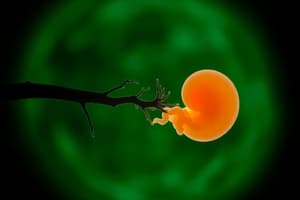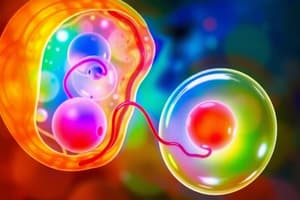Podcast
Questions and Answers
Which of the following processes is NOT directly involved in organogenesis?
Which of the following processes is NOT directly involved in organogenesis?
- Cell migration, moving cells to new locations.
- Cell proliferation, increasing the number of cells.
- Neural tube formation via folding of the neural plate. (correct)
- Apoptosis, programmed cell death to remove unwanted cells.
A developing fetus is exposed to a teratogen during the second trimester. Which of the following outcomes is LEAST likely to occur as a direct result of this exposure?
A developing fetus is exposed to a teratogen during the second trimester. Which of the following outcomes is LEAST likely to occur as a direct result of this exposure?
- Interference with the growth and maturation of existing organs and tissues.
- Increased risk of congenital disorders.
- Functional defects in developing physiological systems.
- Structural abnormalities in newly forming organs. (correct)
During prenatal development, interactions between different cell types and germ layers are crucial. What would be the most likely consequence if these interactions were disrupted?
During prenatal development, interactions between different cell types and germ layers are crucial. What would be the most likely consequence if these interactions were disrupted?
- Increased rate of apoptosis, eliminating defective cells early on.
- Normal organ development due to redundancy in signaling pathways.
- Accelerated cell differentiation leading to advanced development.
- Improper organ development or congenital disorders. (correct)
Which of the following best describes the role of neural crest cells during development?
Which of the following best describes the role of neural crest cells during development?
A genetic mutation affects the process of apoptosis during fetal development. What is the most likely outcome of this mutation?
A genetic mutation affects the process of apoptosis during fetal development. What is the most likely outcome of this mutation?
Which of the following statements accurately describes the relationship between gametogenesis and fertilization?
Which of the following statements accurately describes the relationship between gametogenesis and fertilization?
During cleavage, what is the key characteristic that distinguishes it from typical mitotic cell division in somatic cells?
During cleavage, what is the key characteristic that distinguishes it from typical mitotic cell division in somatic cells?
Which of the following processes is most directly responsible for establishing the three primary germ layers?
Which of the following processes is most directly responsible for establishing the three primary germ layers?
A disruption during neurulation would most likely result in defects within which of the following systems?
A disruption during neurulation would most likely result in defects within which of the following systems?
During fertilization, what critical event activates the egg and initiates embryonic development?
During fertilization, what critical event activates the egg and initiates embryonic development?
Which of the following describes the correct order of events in early embryonic development?
Which of the following describes the correct order of events in early embryonic development?
The mesoderm germ layer is responsible for the development of which of the following structures?
The mesoderm germ layer is responsible for the development of which of the following structures?
Spermatogenesis and oogenesis differ in several aspects. Which statement accurately describes one key difference?
Spermatogenesis and oogenesis differ in several aspects. Which statement accurately describes one key difference?
Flashcards
Neural Tube Formation
Neural Tube Formation
The neural plate folds, forming a groove that closes into a tube which develops into the central nervous system.
Neural Crest Cells
Neural Crest Cells
Cells from the neural plate edges migrate and differentiate into various cell types like peripheral neurons and pigment cells.
Organogenesis
Organogenesis
The process of organ formation from the germ layers.
Congenital Disorders
Congenital Disorders
Signup and view all the flashcards
Teratogens
Teratogens
Signup and view all the flashcards
Embryology
Embryology
Signup and view all the flashcards
Gametogenesis
Gametogenesis
Signup and view all the flashcards
Spermatogenesis
Spermatogenesis
Signup and view all the flashcards
Oogenesis
Oogenesis
Signup and view all the flashcards
Fertilization
Fertilization
Signup and view all the flashcards
Cleavage
Cleavage
Signup and view all the flashcards
Gastrulation
Gastrulation
Signup and view all the flashcards
Neurulation
Neurulation
Signup and view all the flashcards
Study Notes
- Embryology studies the prenatal development of gametes (sex cells), fertilization, as well as the development of embryos and fetuses.
- The study of the formation and early development of living organisms is encompassed within embryology.
- Congenital disorders that occur before birth are also a concern of embryology.
Gametogenesis
- Gametogenesis creates gametes (sperm and egg cells) through meiosis in the gonads (ovaries and testes).
- Spermatogenesis in males produces sperm.
- Oogenesis in females produces eggs (ova).
- Spermatogenesis occurs continuously after puberty, while oogenesis is a cyclic process, starting before birth and continuing until menopause.
- Meiosis in gametogenesis ensures gametes have half the number of chromosomes as somatic cells, maintaining the species' chromosome number after fertilization.
Fertilization
- Fertilization describes the fusion of male and female gametes (sperm and egg) to form a zygote.
- Sperm capacitation, acrosome reaction, penetration of the zona pellucida, and fusion of the sperm and egg cell membranes are all involved.
- After fertilization, the zygote has a diploid set of chromosomes, with half from each parent.
- Fertilization activates the egg, starting embryonic development.
Cleavage
- Cleavage is rapid mitotic cell division of the zygote immediately after fertilization.
- During cleavage, the embryo's size does not increase, but the number of cells (blastomeres) does.
- Cleavage leads to the formation of a morula, a solid ball of cells.
- The morula then develops into a blastocyst, a hollow ball of cells with an inner cell mass (ICM) and a trophoblast.
Gastrulation
- Gastrulation is a crucial stage where the three primary germ layers are established; ectoderm, mesoderm, and endoderm.
- Complex cell movements and rearrangements take place during gastrulation.
- The ectoderm leads to the epidermis, nervous system, and neural crest cells.
- The mesoderm gives rise to muscles, bones, blood, heart, and urogenital system.
- The endoderm leads to the lining of the digestive tract, respiratory system, and associated organs.
Neurulation
- Neurulation forms of the neural tube, which becomes the central nervous system (brain and spinal cord).
- It starts with the formation of the neural plate, a thickened region of the ectoderm.
- The neural plate folds inward to form the neural groove, which then closes to form the neural tube.
- Neural crest cells arise from the edges of the neural plate, migrate, and differentiate into peripheral neurons, pigment cells, and skeletal/connective tissue of the head.
Organogenesis
- Organogenesis refers to organ formation.
- The three germ layers differentiate into specific tissues and organs.
- Interactions between different cell types and germ layers are crucial for organ development.
- Cell proliferation, cell migration, cell differentiation, and programmed cell death (apoptosis) are all components.
Fetal Development
- After the embryonic period (first 8 weeks), the developing organism becomes a fetus.
- Organs and tissues grow and mature during fetal development.
- This period involves rapid growth and increased complexity.
- By the end of fetal development, the fetus can survive outside the uterus.
Congenital Disorders
- Congenital disorders (birth defects) are structural or functional abnormalities during prenatal development.
- They can be caused by genetic and environmental factors (teratogens), or a combination of both.
- Drugs, alcohol, radiation, and infections are examples of teratogens.
- Some congenital disorders are minor, while others are severe and life-threatening.
- Ultrasound, amniocentesis, and chorionic villus sampling help detect these disorders before birth.
Studying That Suits You
Use AI to generate personalized quizzes and flashcards to suit your learning preferences.




